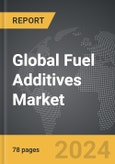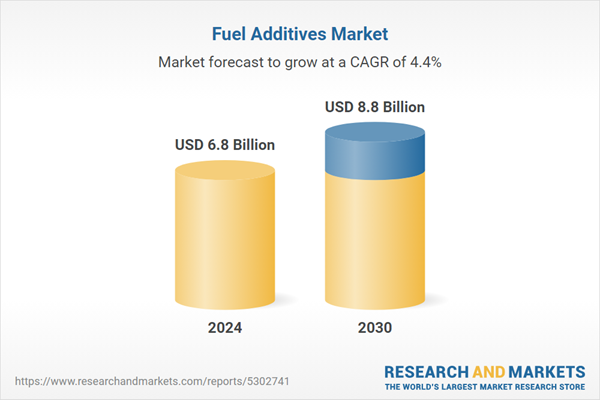Global Fuel Additives Market - Definition, Key Trends & Drivers Summarized
What Are Fuel Additives and Why Are They Essential in Modern Engines?
Fuel additives are chemical compounds formulated to enhance the performance, efficiency, and longevity of fuels used in internal combustion engines. But why are fuel additives crucial in today's automotive and industrial sectors? These additives are designed to improve fuel quality, boost engine performance, reduce emissions, and prevent the formation of deposits that can harm engine components. They are used in gasoline, diesel, aviation fuel, and other types of fuels to address various challenges such as incomplete combustion, corrosion, and fuel instability. For example, detergents in fuel additives help clean engine parts by removing deposits, while antioxidants prevent fuel oxidation and degradation. With stricter environmental regulations and the demand for better fuel efficiency, fuel additives play an increasingly vital role in ensuring engines run smoothly while minimizing environmental impact. As the world shifts toward cleaner and more efficient transportation, fuel additives have become indispensable in meeting modern performance standards and sustainability goals.How Are Technological Advancements Shaping the Fuel Additives Industry?
Technological innovations are driving significant advancements in the fuel additives market, but how are these developments transforming the industry? One of the most prominent trends is the rise of multifunctional fuel additives, which combine several functions - such as cleaning, corrosion prevention, and octane or cetane boosting - into a single additive package. These multifunctional additives provide enhanced fuel efficiency and engine protection, simplifying fuel formulations and reducing the need for multiple products. Additionally, the development of next-generation bio-based and renewable fuel additives is gaining traction as industries focus on sustainability and reducing carbon footprints. Bio-based fuel additives, derived from renewable sources like plant oils and biomass, offer an environmentally friendly alternative to traditional petroleum-based additives, while also improving fuel combustion and reducing emissions.Another technological advancement is the increased use of nanoparticles in fuel additives. Nanotechnology allows for more precise manipulation of fuel properties at the molecular level, improving fuel combustion, reducing wear and tear on engine components, and decreasing emissions. The automotive sector, particularly with the growth of hybrid and advanced internal combustion engines, is benefiting from such innovations, as fuel additives are tailored to meet the specific needs of new engine technologies. These technological advancements are not only enhancing fuel performance but also helping industries comply with stricter environmental regulations.
How Are Regulations and Sustainability Trends Impacting the Fuel Additives Market?
What role do government regulations and sustainability trends play in shaping the fuel additives market? With growing concerns about air pollution and climate change, governments worldwide are implementing stricter emissions regulations, which are pushing the automotive and industrial sectors to adopt cleaner and more efficient fuels. In regions such as North America and Europe, regulatory frameworks such as the Euro 6 emissions standards and the U.S. Environmental Protection Agency (EPA) regulations require automakers and industries to reduce harmful pollutants such as carbon monoxide, nitrogen oxides, and particulate matter. Fuel additives that help reduce emissions, improve fuel efficiency, and extend engine life are becoming essential to meet these stringent standards.Sustainability trends are also playing a major role, with increasing consumer and industry demand for environmentally friendly products. The push for alternative fuels, such as biofuels and renewable diesel, is driving the need for compatible fuel additives that enhance the performance of these fuels. Bio-based fuel additives are gaining attention as they align with global goals of reducing carbon emissions and dependence on fossil fuels. Furthermore, the growing adoption of electric and hybrid vehicles is influencing the development of new fuel additives designed to optimize performance in engines that rely on smaller, more efficient internal combustion systems. These regulatory and sustainability trends are shaping the future of the fuel additives market, encouraging innovation and the adoption of greener, more efficient solutions.
What Are the Key Drivers Behind the Growth of the Fuel Additives Market?
The growth in the fuel additives market is driven by several key factors, including the rising demand for fuel efficiency, the need to reduce emissions, and the increasing adoption of alternative fuels. One of the primary drivers is the global emphasis on improving fuel economy, particularly in the automotive sector, where consumers and manufacturers alike are seeking ways to reduce fuel consumption and operating costs. Fuel additives that enhance combustion efficiency, improve engine performance, and reduce friction are in high demand, especially as vehicles are required to meet stricter fuel efficiency standards.Another major driver is the growing concern over environmental impact and air quality, which is pushing industries to reduce emissions from internal combustion engines. Fuel additives that help lower harmful emissions and particulate matter are becoming critical in meeting the regulatory requirements imposed by governments worldwide. Additionally, the rising popularity of alternative fuels such as biodiesel, ethanol blends, and renewable diesel is creating new opportunities for fuel additives that are specifically designed to optimize the performance and stability of these bio-based fuels.
The expansion of industrial sectors such as shipping, aviation, and power generation is also contributing to the demand for fuel additives, as these industries require high-performance fuels to operate efficiently and comply with environmental regulations. Finally, the ongoing trend of fleet modernization and the rise of hybrid vehicles are driving the need for advanced fuel additives that can cater to the unique requirements of modern, fuel-efficient engines. Together, these factors are propelling the growth of the fuel additives market, making it an integral part of the global effort to enhance fuel performance, reduce emissions, and promote sustainable energy solutions.
Report Scope
The report analyzes the Fuel Additives market, presented in terms of market value (US$ Thousand). The analysis covers the key segments and geographic regions outlined below.- Segments: Type (Deposit Control, Cetane Improvers, Lubricity Additives, Antioxidants, Anticorrosion, Cold Flow Improvers, Antiknock Agents, Other Types); Application (Diesel, Gasoline, Aviation Fuel, Other Applications).
- Geographic Regions/Countries:World; United States; Canada; Japan; China; Europe (France; Germany; Italy; United Kingdom; Spain; Russia; and Rest of Europe); Asia-Pacific (Australia; India; South Korea; and Rest of Asia-Pacific); Latin America (Argentina; Brazil; Mexico; and Rest of Latin America); Middle East (Iran; Israel; Saudi Arabia; United Arab Emirates; and Rest of Middle East); and Africa.
Key Insights:
- Market Growth: Understand the significant growth trajectory of the Deposit Control segment, which is expected to reach US$2.2 Billion by 2030 with a CAGR of a 5.2%. The Cetane Improvers segment is also set to grow at 4.5% CAGR over the analysis period.
- Regional Analysis: Gain insights into the U.S. market, valued at $1.8 Billion in 2024, and China, forecasted to grow at an impressive 6.5% CAGR to reach $1.8 Billion by 2030. Discover growth trends in other key regions, including Japan, Canada, Germany, and the Asia-Pacific.
Why You Should Buy This Report:
- Detailed Market Analysis: Access a thorough analysis of the Global Fuel Additives Market, covering all major geographic regions and market segments.
- Competitive Insights: Get an overview of the competitive landscape, including the market presence of major players across different geographies.
- Future Trends and Drivers: Understand the key trends and drivers shaping the future of the Global Fuel Additives Market.
- Actionable Insights: Benefit from actionable insights that can help you identify new revenue opportunities and make strategic business decisions.
Key Questions Answered:
- How is the Global Fuel Additives Market expected to evolve by 2030?
- What are the main drivers and restraints affecting the market?
- Which market segments will grow the most over the forecast period?
- How will market shares for different regions and segments change by 2030?
- Who are the leading players in the market, and what are their prospects?
Report Features:
- Comprehensive Market Data: Independent analysis of annual sales and market forecasts in US$ Million from 2024 to 2030.
- In-Depth Regional Analysis: Detailed insights into key markets, including the U.S., China, Japan, Canada, Europe, Asia-Pacific, Latin America, Middle East, and Africa.
- Company Profiles: Coverage of players such as Afton Chemical Corp., Baker Hughes, Basf SE, Cerion LLC, Chevron Oronite Company LLC and more.
- Complimentary Updates: Receive free report updates for one year to keep you informed of the latest market developments.
Some of the 12 companies featured in this Fuel Additives market report include:
- Afton Chemical Corp.
- Baker Hughes
- Basf SE
- Cerion LLC
- Chevron Oronite Company LLC
- Clariant AG
- Cummins, Inc.
- Dorf Ketal Chemicals
- Evonik Industries AG
- Huntsman Corp.
- Inf Ineum International Ltd.
- Innospec, INC.
- Lanxess
- Lubrizol Corp.
- Solvay
This edition integrates the latest global trade and economic shifts into comprehensive market analysis. Key updates include:
- Tariff and Trade Impact: Insights into global tariff negotiations across 180+ countries, with analysis of supply chain turbulence, sourcing disruptions, and geographic realignment. Special focus on 2025 as a pivotal year for trade tensions, including updated perspectives on the Trump-era tariffs.
- Adjusted Forecasts and Analytics: Revised global and regional market forecasts through 2030, incorporating tariff effects, economic uncertainty, and structural changes in globalization. Includes historical analysis from 2015 to 2023.
- Strategic Market Dynamics: Evaluation of revised market prospects, regional outlooks, and key economic indicators such as population and urbanization trends.
- Innovation & Technology Trends: Latest developments in product and process innovation, emerging technologies, and key industry drivers shaping the competitive landscape.
- Competitive Intelligence: Updated global market share estimates for 2025, competitive positioning of major players (Strong/Active/Niche/Trivial), and refined focus on leading global brands and core players.
- Expert Insight & Commentary: Strategic analysis from economists, trade experts, and domain specialists to contextualize market shifts and identify emerging opportunities.
Table of Contents
Companies Mentioned (Partial List)
A selection of companies mentioned in this report includes, but is not limited to:
- Afton Chemical Corp.
- Baker Hughes
- Basf SE
- Cerion LLC
- Chevron Oronite Company LLC
- Clariant AG
- Cummins, Inc.
- Dorf Ketal Chemicals
- Evonik Industries AG
- Huntsman Corp.
- Inf Ineum International Ltd.
- Innospec, INC.
- Lanxess
- Lubrizol Corp.
- Solvay
Table Information
| Report Attribute | Details |
|---|---|
| No. of Pages | 267 |
| Published | December 2025 |
| Forecast Period | 2024 - 2030 |
| Estimated Market Value ( USD | $ 6.8 Billion |
| Forecasted Market Value ( USD | $ 8.8 Billion |
| Compound Annual Growth Rate | 4.4% |
| Regions Covered | Global |









